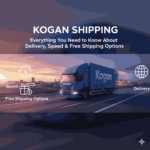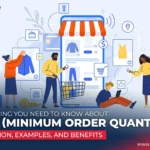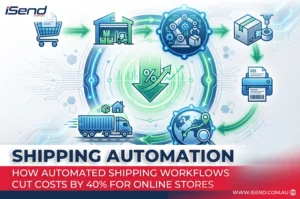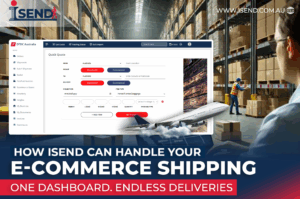Have you ever ordered something online and then faced a frustrating delivery experience, such as delayed shipping or poor communication? No matter how good the product turned out to be, if the delivery experience was subpar, you might not buy from that seller again.
Look at this staggering data: 21% of consumers lose faith in the brand following a delayed delivery, and 23% of consumers say they won’t purchase from the same business again.
Indeed, a smooth order fulfilment process brings customers back and improves business operations. Dive into this blog to learn everything about order fulfilment from scratch.
What is Order Fulfilment?
Order fulfilment is the entire process of receiving, preparing, and delivering e-commerce orders. Customer order fulfilment starts with placing orders and ends with orders delivered to the customers’ doorsteps.
A strategic order fulfilment process is game-changing for any e-commerce business.
Here is how it drives multiple benefits for e-commerce platforms:
- Customer satisfaction
It increases when purchases are delivered precisely and on schedule. It increases the likelihood of repeat orders and referrals, boosting future sales.
- Brand reputation
An e-commerce business with great order fulfilment services gains trust and credibility in the marketplace. This positive image elevates the business’s reputation a notch.
- Operational efficiency
A robust order fulfilment system minimises order errors and improves inventory management. Eventually, it results in reduced costs and maximum productivity, which allows businesses to operate smoothly!
- Profitability
Beyond the positive impact on logistics, a good order fulfilment process also strengthens profits for businesses. They can complete more orders with quicker order processing times, which boosts sales and profitability.
Step-by-Step Breakdown of the Order Fulfilment Process
The fulfilment of e-commerce orders is a collection of multiple steps! Depending on the business size, you may go through all the steps or just a few.
- Inventory Management
E-commerce stores depend on real-time inventory tracking software to monitor the number and condition of products. Effective inventory management helps avoid overselling, reduces storage costs, and ensures the right items are available when customers place orders. Irrespective of the size of the business, inventory management is a fundamental order fulfilment process.
- Order Processing
In this stage, the customer’s order is checked for availability. The e-commerce order fulfilment software then generates a pick list for warehouse staff.
- Picking & Packing
Next, the on-ground workers pick the product from the warehouses and pack it for delivery. To do this, a picker is given a packing slip that lists the facility’s items, quantities, and storage locations.
- Shipping & Delivery
The packed order must be shipped next. Both small and large e-commerce businesses have shipping partners. Customers are shared with tracking information so they can monitor the package in real time. This is the final leg of the order fulfilment process, and customer expectations peak here.
- Returns Management
If the customer is not satisfied with the product, it is returned. A clear return policy builds trust and encourages more purchases. The goal is to make the return experience as smooth as the buying experience. However, this is a complex stage because returns might come through any channel, and handling becomes difficult due to this.
- Customer Communication
24/7 customer communication must be available throughout the order journey, as it builds trust. Customers often need information regarding their product, delivery, or returns. Businesses must keep multiple communication channels open, such as emails, chats, or phone calls.
Common Challenges in Customer Order Fulfilment
Irrespective of how advanced the order fulfilment software is, small and large businesses face challenges.
- Stockouts and overstocking due to poor forecasting
If the predictions about demand patterns are inaccurate, stockouts and overstocking become frequent occurrences. Stockouts, especially for best-selling products, cause businesses to lose customers, and overstocking ties up capital and warehouse space.
- Picking/packing errors leading to wrong or damaged items
Incorrect order details lead to customers receiving the wrong items. This significantly hurts customer satisfaction and affects profitability.
- Courier delays, lost packages, or high shipping costs
Another common challenge is package loss during shipment. It impacts the brand reputation. Similarly, high shipping costs can lead to people abandoning their carts. According to data, 48% of customers leave products in their carts due to high shipping costs.
- Complicated or costly returns processes
A complex or expensive return policy discourages customers and adds friction to their post-purchase experience.
- Insufficient notifications causing customer frustration
Customers love to stay informed about their orders. Lack of communication from the seller can lead to a loss of trust and reliability.
All of these are daily challenges businesses face in the order fulfilment process. While complete eradication may not be possible, a solid strategy can reduce the magnitude of these challenges.
E-commerce Platforms and Integration (Shopify, WooCommerce, etc.)
Choosing the right e-commerce platform will largely determine the quality of the order fulfilment process. Platforms like Shopify and BigCommerce offer built-in tools and integrations that simplify inventory tracking, order processing, shipping, and reverse logistics. Specifically, order fulfillment Shopify workflows are known for their ease of use. Integrating these platforms reduces the scope of errors and operational costs and results in improved efficiency.
After narrowing down the e-commerce platform, businesses need to make the big decision of choosing the method for order fulfilment. There are three main approaches: in-house, third-party logistics (3PL), and dropshipping.
In-House vs Third-Party Ecommerce vs Dropshipping Order Fulfilment
This table highlights the difference between the three methods.
| Basis | In house | Third Party | Dropshipping |
| Control over inventory | Businesses control the inventory | Inventory handled at 3PL warehouse | Supplier controls the inventory |
| Suitability | Small businesses | Businesses in take-off stage | New businesses testing products |
| Client experience | High: Offers personalized packing | Moderate: depends on 3rd party standards | Usually low: May have slower service |
| Costs | Quite high | Medium costs | Very low |
Order Fulfilment Software for Small Business
The choice of order fulfilment software makes all the difference. It is a complete solution for small businesses to automate, manage and optimise their entire order fulfilment process. The e-commerce order fulfilment software handles ordering mechanisms from start to end.
But with so many software options available, one might feel spoilt for choice. Here are some features to help you narrow down the ultimate order fulfilment software for your small business.
Features to Look for in E-commerce Order Fulfilment Software
● Real-time inventory tracking across channels
You should be able to track inventory across all your sales channels. This helps prevent situations of stockouts or overstocking.
● Multi-carrier shipping rate shopping and label printing
Shipping can quickly become expensive and time-consuming if you’re not comparing carrier rates. The best software allows you to compare rates from multiple carriers automatically. You should also be able to generate and print shipping labels instantly.
● Batch picking/packing workflows
The right software allows picking and packing multiple orders simultaneously to increase efficiency.
● Returns management portal
Return logistics is quite complex and at the same time pretty prevalent in the e-commerce business. So, having the return management portal improves internal efficiency and customer experience.
● Reporting dashboards
Data helps businesses improve their products and services to boost growth. Fulfilment software should offer dashboards that show order accuracy, average processing time, delays, returns and more.
● Integrations with your store, accounting, and CRM
The best software integrates with the ecommerce platform, accounting software and CRM tools. The data flows smoothly across all platforms and provides a unified ecosystem.
If you can find all these features in one fulfilment software, that is where you end your search!
Australian Order Fulfilment: Local Considerations
Australia is a thriving location for e-commerce businesses. According to data, 17.08 million Australian shoppers used online shopping websites monthly in 2024. To tap into this potential, businesses must tailor their order fulfillment strategy to meet local expectations.
One of the most effective ways to optimise is local warehousing. Strategically located local warehouses add to the reduction of costs and quick delivery. This enhances the customer experience with faster turnarounds and minimises cross-border logistics complexities.
Local warehousing also makes reverse logistics easier and manageable. Beyond efficiency, local warehousing also supports inventory management by allowing businesses to store high-demand products closer to their target market. All of this together provides an e-commerce business with a competitive advantage.
Choosing the Right Order Fulfilment Services
The right order fulfilment services can make or break your business, so it is essential to take some time to research the best Australian order fulfilment service.
Look for those service providers who use the latest technology to ensure an efficient and cost-effective order process with the highest level of accuracy and a range of different packaging options tailored to your requirements.
There are multiple factors to be considered:
- Shipping time
- Location of warehouses
- Features of the fulfilment software used
- Communication channels
- Packaging options
- Returns management
- Costs
Conclusion
To draw curtains on the order fulfilment process, this process is pivotal for the success of e-commerce. It’s the clutch moment where brands either grow or stumble. Whether you are a small or large-scale business, you need order fulfilment services for efficient business operations. So, conduct thorough market research to identify potential providers who fit within your budget and align with your business goals. It is time to grow your business with ease!!








